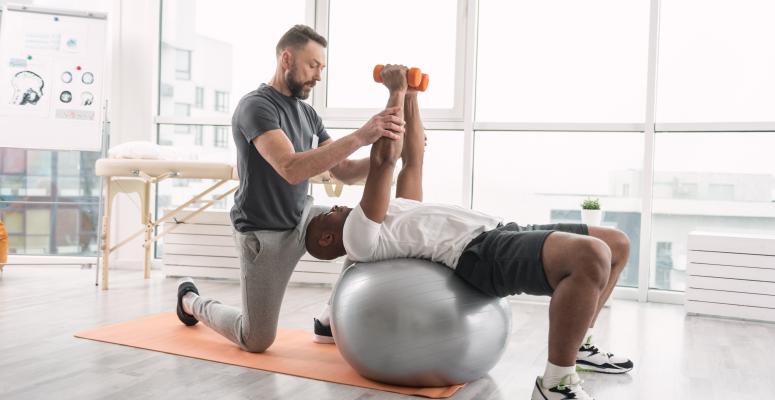
Rehabilitation and injury prevention are both important parts of sports performance physical therapy. Physical therapists help a lot of athletes with knee pain and foot and ankle pain. Many of these sports injuries are the result of traumatic injuries; others develop sports injuries over time from strain, overuse and repetitive movements. But if these are the only things you work on with your PT, you’re missing out on a lot of other benefits.
Physical therapists are experts on the biomechanical processes at play when you’re training, performing and resting. They have a broad range of tools and treatments at their disposal to help you optimize and enhance your performance. Some of these are exercises and stretches. They can also use more passive physical therapy techniques like manual therapy and cupping. Your physical therapist can even help you with the psychological aspects of your sport and sports performance anxiety.
Achieving your best sports performance takes a combination of training, conditioning, nutrition, and mental preparation in addition to recovery and injury prevention. You need to work on the fundamentals of strength, flexibility, agility and form as well as the finer points of your sport.
Physical therapists can help with all of these things and more. This article outlines 10 ways a physical therapist can help you with your sports performance.
How can a physical therapist help me with sports performance training?
A physical therapist will start your initial sessions by asking about what your training and competition schedule is like and what goals you have for your sports performance. Some advanced athletes are more concerned about preventing pain and injuries. Others might be more focused on developing strength and control for better form. Your PT will work with you to create a detailed plan that takes several things into account: Your goals, skill level, history, and any injuries or medical conditions you have are all relevant.
Your physical therapist will also spend some time assessing your form and your current strengths and weaknesses. They can help you decide what to work on first and strategize your sessions to make the most impact, both while you're competing and in the offseason.
10 ways a physical therapist can help you with sports performance training
Your physical therapist is another teammate in your corner in addition to your coaches, trainers and team members. For solo athletes like tennis players, figure skaters and gymnasts, having more supporters can make a huge difference. A PT can bring a more holistic perspective to keep your overall lifetime wellness in mind.
There are many aspects of your sport a physical therapist can help with, both physical and mental. The following are 10 top examples:
- Preventive care — Many sports like cycling, tennis, running and swimming involve a lot of repetitive movements that can cause damage over time. High-contact sports — football, wrestling and basketball, for example — come with a higher risk of traumatic injury. A physical therapist can help you prevent injuries from strain, accidents and degenerative conditions like arthritis. Strengthening exercises, balance training and orthopedic care are just a few techniques they might start with.
- Optimizing and enhancing performance — Your PT’s initial assessment can help uncover potential biomechanical issues and weak points in your form. They’ll put together a personalized treatment plan with exercises that target specific concerns and help you improve your all-around performance. You may work on building strength, endurance, speed, flexibility, coordination, agility, confidence and more.
- Identifying weaknesses and imbalances — Over time, a weak point in your form can slow you down and make injuries more likely. Your PT will look for potential weaknesses and imbalances during their initial assessment and stay on the lookout during your sessions.
- Balance and coordination — These are some of the basic building blocks all great athletes need to excel at their sport. Your physical therapist may guide you through different types of conditioning, dynamic stretches and isolation exercises to work on specific issues and muscle groups. For example, plyometric exercises combine jumping and powerful repetitive movements to refine your “fast-twitch” muscles. You may use equipment like an exercise ball or a BOSU (“both sides up”) balance trainer. Or you might use medicine balls, kettlebells and resistance bands to build strength.
- Flexibility and agility — Some athletes make the mistake of skipping stretches after their workouts, which is a common cause of injuries. Your physical therapist can help you develop a stretching regimen that targets the right muscle groups and enables you to recover faster between workouts and events. They can also show you dynamic and compound exercises that involve multiple muscle groups.
- Strength and control — Strength and endurance are the elements that power your performance. You also need control to execute the specific movements that make it great. A PT will make sure your treatment plan balances both to make you an all-around better athlete.
- Kinesiology taping — At certain points in your athletic career, your muscles may need a little extra support to function the way you need them to. Some physical therapists use kinesiology taping to add support, retrain muscles or relieve pain during training sessions and competition.
- Rehabilitation after sports injuries — Of course, your PT will be there to help you if and when you need to recover after an injury. Sometimes this calls for modified exercises to maintain your strength while an immobilized limb heals. And some athletes need help with the psychological impact of resting when they would rather be training. As soon as it’s safe to start training again, your PT can help you rebuild strength, range of motion and balance to make a safe and confident return.
- Managing or eliminating pain — Not all injuries require you to sit out practices and competitions; however, you shouldn’t be “pushing through the pain” on a regular basis. A physical therapist can help you minimize pain as it comes up. They may give you specific instructions for resting and recovery, or they may strengthen certain muscles to take the pressure off the affected area. In addition, they might use equipment like kinesiology tape or a brace to partially immobilize certain muscles.
- Psychology of sports performance — Athletes put a lot of time and effort into achieving their optimal performance. It’s understandable that you should be emotionally invested in your athletic career. Having a consistently excellent performance requires mental resilience, confidence and a bit of strategy. PTs can help with all of these things, and they can help you manage performance anxiety and fears, too.
Alliance PTP is ready to help you find top-notch PT for sports performance enhancement
When you choose to find a physical therapist to help you with your sports performance, finding the right match is very important. You’ll want them to have the right skills and experience, and you’ll need to have a good rapport. At Alliance Physical Therapy Partners, we’re proudly bringing together physical therapy practices across the country to help people get the high-quality PT they need. We can help connect you with the right therapist to take your performance to the next level.
Want to see a physical therapist in person? We can put you in touch with an Alliance PTP partner that’s close to you and that can help you with your sports performance.
Don’t have the time to see a physical therapist in person? Not a problem. Alliance PTP and its partners can see you virtually in nearly every state for athletes with busy schedules.
Are you ready to meet your performance enhancement partner? Come find help for sports performance today!
Get Help at a Location Near You
